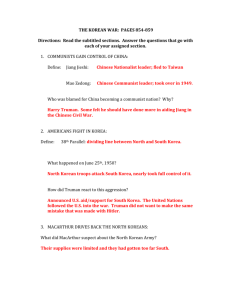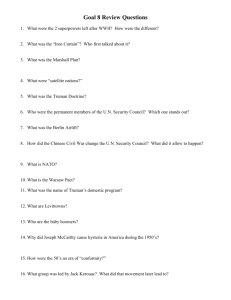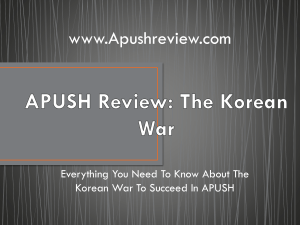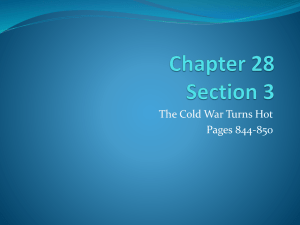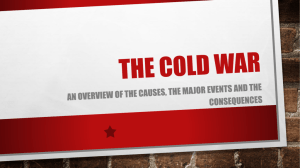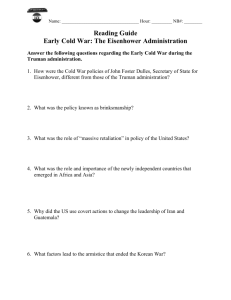The Cold War Expands - Trimble County Schools
advertisement
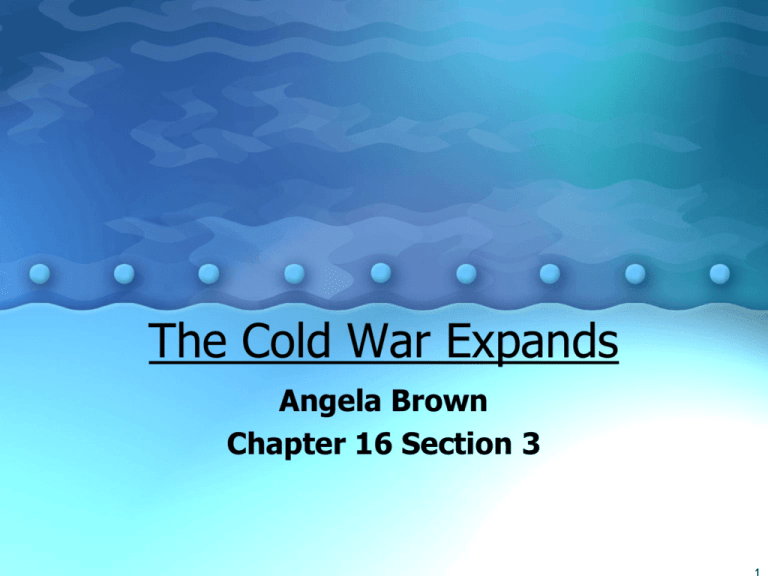
The Cold War Expands Angela Brown Chapter 16 Section 3 http://www.ambrosevideo.com/resources/docs/200.JPG The Korean War •1945 Allies divide Korea into SovietOccupied northern zone and an American – Occupied Southern Zone. •Occupying forces withdrew from both zones in 1948-1949. http://teachpol.tcnj.edu/amer_pol_hist/fi/0000019f.jpg Korean War • June 1950, the Korean War broke out when North Korean troops streamed across the 38th parallel, the latitude dividing the two nations, aiming to reunite Korea by Force. • The USSR was boycotting the Security Council protesting the exclusion of Communist China, the UN was able to act to defend South Korea. Today http://www.landofthemorningstorm.com/Pictures/38th.jpg Douglas MacArthur •Hero of two World Wars – strong anticommunist Truman’s choice to lead UN forces in Korea •Graduated from U.S. military academy at West Point in 1903 http://www.history.navy.mil/photos /images/h62000/h62439.jpg MacArthur • Cited 7 times for bravery in WWI and by 1918 at age 38 he attained rank of general. • 1930 Army Chief of Staff • WWII – Commander of American forces in Asia • Virtual dictator of Japan during postwar – responsible for establishing Western Democracy – creating new democratic constitution MacArthur • Less successful in implementing democracy in South Korea – supported South Korean President Syngman Rhee • Hero to troops and American Public • Disliked as overly ambitious by political leaders MacArthur • MacArthur had little respect for both Roosevelt and Truman. • He viewed them as soft on communism. • He had contempt for anyone with authority over him; it undermined his otherwise brilliant career. The Korean War • Excellent military strategist, MacArthur, developed a bold plan to drive the invaders from South Korea. • South Korea overtaken in just a few weeks – except small part near port city of Pusan. • Guessed that swift advance had left supply lines stretched thin. • Sept 1950 attacked enemy supply lines from behind and sent forces to defend Pusan. http://www.mapzones.com/citymap/south_korea/pusan/pusan.jpg Korean War • His strategy worked . The North Koreans fled back across 38th Parallel. • UN troops pursued them Northward and began boasting of reuniting Korea under South Korean government. • Chinese joined North Koreans and pushed UN forces back into South Korea; a stalemate developed. • MacArthur favored opening a second front by bringing Chinese opposition from Taiwan under Jiang Jieshi to fight communist Chinese. • Truman opposed; he feared widespread war in Asia. MacArthur Fired • MacArthur sent letter to House minority leader Joseph Marlin in March 1951 attacking the President’s policy. • Martin made letter public; on April 11 Truman fired MacArthur for insubordination. • The struggle dragged on for two more years. Truce? • 1953 truce signed; left Korea divided by the 38th parallel as before. • Americans wondered why 55,000 soldiers had been killed and 103,000 wounded for limited results. • Was the U.S. serious about stopping communism? The Cold War in the 1950s • 1953 Eisenhower succeeded Truman. • New phase of Cold War policy • Sec of State John Foster Dulles called for a policy to roll back communism. • Eisenhower recognized risk of confronting Soviets did not intervene in revolts in Eastern Germany, Poland and Hungary in 1956. • Policy of containment continued. Dwight D. Eisenhower http://www.americaslibrary.gov/assets/aa/eisenhower/aa_eisenhower_subj_e.jpg Southeast Asia • July 1953 fulfilled campaign promise to end Korean War – aided by death of Stalin in March. • Conflict developed in Vietnam – French colony • 1945 Ho Chi Minh, head of Vietnamese Communist Party declared independence. Ho Chi Minh http://www.facade.com/celebrity/photo/Ho_Chi_Minh.jpg Domino theory • France sent troops to reassert authority = war • Eisenhower believed in Domino theory • If one country fell to communists its neighbors would soon follow. • By 1954 U.S. providing military aid to support France in Vietnam. http://www.lib.utexas.edu/maps/middle_east_and_asia/vietnam_pol92.jpg http://dsf.chesco.org/heroes/images/s_vietnam_map.gif Vietnam • May 1954, major defeat = France withdrew forces • International conference divided Vietnam like Korea. • U.S. provided aid to South Vietnam but resisted greater involvement. The Middle East • British controlled Palestine – region on Med. Coast and biblical home of Jewish people • 1930s many Jews sought safety in Palestine – called for a Jewish state • 1947 British turned over to UN – created two states one Jewish and one Arab Palestine Israel - Iran • May 1948 Jews in Palestine proclaimed new nation of Israel. • Arab nations opposed – backed by Soviets • U.S. worked to prevent oil-rich Arab nations from falling to Soviets. • 1952 nationalist leader gained control in Iran • U.S. (CIA) organized overthrow – returned power to pro-American Shah of Iran Israel http://ec.europa.eu/comm/external_relations/israel/images/acp_israel_w600.gif Suez Crisis • Suez Crisis in 1956 – Egypt’s ruler, Nasser, sought Soviet support • U.S./GB stopped aid. • Nasser seized the Suez Canal a vital waterway through Egypt allowing Middle East oil to reach Europe. • 1956 British and French attack Egypt. • Eisenhower persuaded NATO allies to withdraw from Egypt. Suez Canal http://www.yachtaragorn.com/maps/large/DjiboutitoSuezCanal.jpg Eisenhower Doctrine • 1957 announced Eisenhower Doctrine • The U.S. would use force to safeguard independent countries in Middle East requesting aid against aggression. • Used Doctrine in 1958 to put down revolt against Lebanese government. Latin America • 1947 Rio Pact – a regional defense alliance with 18 other nations in the Western Hemisphere. • 1948 formed organization of American States (OAS) to increase cooperation among nations of Hemisphere. Latin America • 1954 CIA helped overthrow government of Guatemala. • Leaders were sympathetic to radical causes. • Restored property of United Fruit company seized by Guatemalan government from American corporation. Guatemala Cuba • 1958 Fidel Castro overthrew corrupt Cuban dictator Batista. (ties to U.S. organized crime) • Eisenhower would not support Castro; CIA reported infiltration of movement by communist. • Castro seized U.S. property in Cuba; Eisenhower cut diplomatic ties and halted exports to Island. • Castro turned to Soviets for economic and military aid. Leadership Change http://www.law.harvard.edu/students/orgs/forum/castro.jpg http://alocubano.com/batista8.gif Republic of Cuba The Arms Race • Arms Race – struggle to gain weapons superiority The Growth of Nuclear Arsenals • 1953 one year after U.S test of thermonuclear device, Soviets tested hydrogen device. • 1953 Eisenhower announced atoms for Peace Plan at UN. First Hydrogen Test • World’s nations work together under UN supervision to find peaceful uses for nuclear technology; Soviets refused to participate. • Eisenhower stepped up American weapons development program. • First hydrogen test in March 1954; 750 times more powerful than bomb dropped on Nagaski. Results • Japanese fisherman 90 miles away radiation burns-Island 200 miles away evacuated • Test revealed nuclear war threatened entire world with radioactive contamination. http://www.gensuikin.org/panel/13.jpg Brinkmanship • 1956 Secretary of State Dulles stated U.S. prepared to risk war to protect national interest. • Brinkmanship – ability to get to verge without getting into war Cold War in the Skies • U.S. Airforce to carry hydrogen bombs to targets; Soviets could not match strength. • Developed ICBM’s – long-range rockets known as intercontinental ballistic missiles as primary delivery system • U.S worked to develop ICBM’s lagged behind Soviet’s in missile development due to dependence on conventional air power. ICBM launch http://upload.wikimedia.org/wikipedia/commons/thumb/d/d5/Atlas-icbm-erector-scaled.jpg/300pxAtlas-icbm-erector-scaled.jpg Sputnik • Technological gap startling in 1957; Soviets used one of rockets to launch Sputnik – first artificial satellite to orbit Earth. • Americans mortified – rocket could carry hydrogen bomb to U.S. • U.S. satellite rushed to launch before ready; crashed. Sputnik http://www.aerospaceweb.org/question/spacecraft/russia/r7-sputnik.jpg U-2 incident • U-2 incident – Soviets shot down U.S. spy plane over Soviet Union with guided missile. • It flew 15 miles high; we assumed it was immune to attack. http://www.lswilson.ca/u2-3.jpg Gary Powers http://www.nndb.com/people/105/000057931/powers-crop.jpg http://www.nasm.si.edu/exhibitions/lae/images/LE284L9.gif Sentence • Francis Gary Powers: Imprisoned Powers spent almost 21 months in prison in the Soviet Union. • During that time, he openly kept a diary of his daily activities. • In November 1960 he began secretly writing a journal, which opens with a detailed recounting of the downing of his U-2. • When released, Powers hid the diary and journal in a rug he had embroidered while in prison and carried them out of the Soviet Union. http://www.nasm.si.edu/exhibitions/lae/script/ss_flyers.htm
